
THE DEAD TIMES
DEAD ARE COMING...
Zombie Crier - The Dyatlov Pass Incident

© Screenshot from PC game Kholat
Welcome friends, to the start of a whole new series - one where I look into unsolved mysteries, ancient or up-to-date, and ask the only question I am qualified to ask: "was it Zombies?" (assuming that Zombies do indeed exist, which, of course, they do). It's a series I have wanted to start for a while - unexplained events have always been an area of particular interest for me - and while most offer no suggestion of undead involvement, there is always hope for a wayward Zombie fan looking to stick his nose into places it is neither needed, nor wanted.
On June 10th 2015, an indie game entitled Kholat, made by first-time developers IMGN.PRO, was released for the PC. Being inspired by the true events of the mysterious and unexplained "Dyatlov Pass Incident", this - to my untrained, attention-hopping mind - was the perfect time to don the deer-hunter cap of investigation and conclusively prove, once and for all, whether Zombies had a part to play in whatever strange events took place at Dyatlov Pass.
What is the Dyatlov Pass Incident?
On January 27th, a group of ten young but experienced hikers set out to reach Otorten, a notable mountain contained within the Ural Mountain range of Russia. The following day, one of the trekkers became ill and was forced to turn back to the nearest inhabited settlement. The nine remaining hikers, continued on.
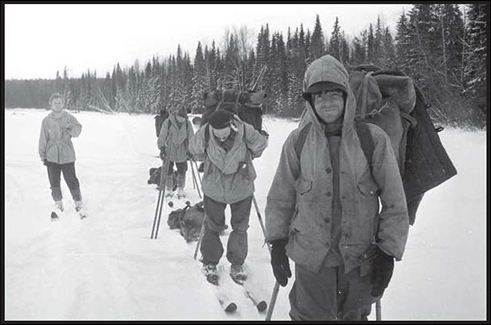
© The Dyatlov hikers, Janurary 30th 1959 | Investigating the Mystery
Just before the now-infamous Pass, the remaining crew came upon a forested area where they cached food and equipment for the trip back, beginning the difficult traversing climb with the aim of crossing the Pass before nightfall, postponing setting up camp until they reached the opposite side. However, due to bad weather - snowstorms and deteriorating visibility - the team, unknowingly, started trundling westward towards the summit of Kholat Syakhl, a mountain spookily known as "Dead Mountain" in the local Mansi dialect. They realised their mistake as the daunting peak loomed into view and, with the weather so bad, the only option left was to set up camp where they were, on the slopes of the mountain.
Meanwhile, back in civilisation, Yudin - the hiker who turned back on the second day of the trek - awaited the telegraph Dyatlov - the company's leader - had agreed to send in appropriate time to arrive on February 12th. The 12th came and went without receipt of said telegraph. Delays were nothing new for this far-flung part of the world though so Yudin did not worry.
Days passed with still no word. People started to grow anxious that something had happened to the group and, on the 20th of February, a rescue team was dispatched (even the army was called in to assist the search). On February 26th, they found the camp set up by the missing hikers on the slopes of Kholat Syakhl.
The camp was abandoned and badly damaged - the student who discovered the camp was reported to have said "the tent was half torn down and covered with snow. It was empty, and all the group's belongings and shoes had been left behind.". However, the mystery deepened when investigators discovered that the tent had been cut open from the inside. Eight or nine sets of footprints, coming from the camp, left by inhabitants wearing only their socks, a single shoe or even barefoot, led 1.5 kilometres away, down to a wooded valley on the opposite side of the Pass. There was evidence of a large fire in this location and the bodies of two hikers from the missing expedition were found buried beneath a thin layer of the snow, leaving the group as seven. Each body was shoeless and dressed only in their underwear. The tree nearest their fallen corpses had several branches broken at a height of 5 metres suggesting that one, or both, of the hikers had tried to climb it, falling to their deaths (or debilitating injury) moments later.
Later excavations uncovered three more of the hikers' bodies between the forest and the deserted camp - their lifeless bodies posed in such a way to seemingly be returning from the forest to the tent. That still left four of the hiking party unaccounted for.
For a further two whole months of continued searching, nothing was found. Then, on May 4th, the remaining bodies were discovered, 75 metres further into the forest, buried under deep snow inside a ravine. It appeared as though the two surviving groups - the three who chose to return to the tent and the four who continued walking in the forest - had taken the clothes from the two initial fallen comrades, presumably trying to stay warm in the sub-zero mountain temperatures.
The first five bodies had no major injuries so it was concluded, they all died of hypothermia. The last four bodies, however, did all have fatal injuries and pretty extreme ones at that - a skull fracture and serious chest injuries that could only have been caused by equivalent force to a car crash. Here, mystery creeps in as none of the bodies had any external injuries save for one who was missing their tongue, both eyes, part of their lips and some skin from their face.
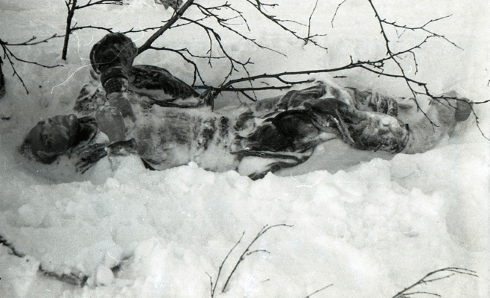
© The body of one of the hikers, unearthed from the snow | The Tragical Expedition
Theories
There are hundreds of theories surrounding the fateful Dyatlov Pass Incident. The most obvious explanation is an avalanche; snow covered, badly damaged tent, the hikers moving off to a nearby forest in a hurry and one group staying with the tent while the other goes for help - it all fits. However, this easy explanation misses various glaring facts.
- The skin of at least five of the hikers had, according to their friend who attended the funerals, taken on a "deep brown tan".
- Some of the clothing taken from one of the bodies was found to be highly radioactive.
- A separate group of hikers, 50 kilometers south of the incident, reported seeing two orange spheres in the direction of Kholat Syakhl on the night the Dyatlov team went missing. Similar orange sphere sightings were reported throughout that area during the February / March period both by the meteorology service and the military.
- There was a ton of scrap metal near the bodies and around the Pass area hinting at secret Military exercises taking place.
- The last camp the hikers made was on a direct path between a Russian space launch facility, known for testing the never-put-into-operation intercontinental ballistic R-7 missile, and an area used by the Soviet Union for nuclear testing.
- The files of the case were sent to a hidden archive and kept secret until the 1990s. To this day, only a portion of those files have been released.
The Zombie Theory
So it turns out, and you'll be surprised to read this, but it takes a fair deal of imagination to "come up" with a semi-plausible theory for Zombies being behind the infamous Dyatlov Pass Incident. I mean they don't really fit the facts. The first glaring problem is how would Zombies, or even just a single Zombie as may be more likely in this case, come to be on the mountain? I mean, Zombies are not known for their agility or stamina. So while it is possible one followed the hikers or an earlier group of hikers up the mountain, it's more likely that it was on the mountain in the first place. Remember that the living dead do not require or generate body heat - they are just walking sacks of vengeful meat basically - so they can "survive" being frozen solid and defrosting. Perhaps a Zombie was led up their, following food during an outbreak lost in history, catching its prey, only to be locked in an icy tomb come the freezing Winter temperatures at altitude. Thawing in the Summer, the insipid creature would wander aimlessly, lacking the intelligence to descend the mountain or possibly, having broken bones on ill-placed rocks, simply being unable to move. In fact, this presence of the dead on the mountain could be why the mountain was known as "Dead Mountain" in the first place. (Okay, I'm reaching a bit.)
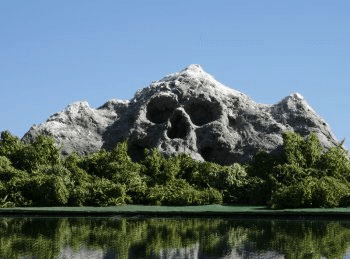
© This is not what "Dead Mountain" looks like | 6 Famous Unsolved Mysteries (With Really Obvious Solutions)
The theory continues by borrowing from the officially-accepted avalanche theory. An avalanche would be the perfect conduit to transfer the undead Zombie to the life-filled hiking team. As the avalanche roared into the camp, ripping through the thin tarpaulin of the tent, the Zombie was deposited within. Being buried by snow is bad enough before you consider a mindless dead thing in your midst, groaning and snarling as it tries to manoeuvre its mangled body into biting range - the hikers had to get out and get out quickly! One clever soul drew a knife to cut themselves free of their battered canvas tomb. Getting out, no time to don sensible footwear, the nine panicked hikers raced out into the snow. Fearing the morbid horror may come after them, they chose to head to the nearby forest - they assumed cover would save them, out of instinct rather than careful thought. Getting there, they wait. And wait. And wait. Cold eventually forces them to light a fire, a small one, not something that would be clearly visible from the tent but enough to produce the warmth they so badly needed - it was a risk, they would have known that but in the cold of night, temperatures well below zero, what choice would they have had. Besides, after being brought down the mountain in the torrent of snow and rocks, the Zombies legs will most definitely be broken - or so the group hopedů
Two of the hikers climb the nearby tree, looking for their attacker from a raised vantage point. In the scenario where the Zombie could still walk - the one I am going to focus on for this theoretical brain-wandering - the unfortunate creature is stumbling around with no direction or bearing - out of "sense" range of our heroes. The walking terror staggers around for hours, constantly slipping on snow, changing direction to revisit the same old areas after he manages to scramble to his feet. The branches holding the two hikers aloft, snap, unable to withstand the weight any longer - the climbers to plummet the ground, suffering movement-forbidding injuries. The flames of fire dwindling and the cold returning to the dismayed band, the group now faces an urgent choice - leave their injured comrades behind and hike back down the mountain pass or return to the camp, grab the flare gun and signal for help at the risk of alerting the demonic corpse thrown into their world.
The group decide that they cannot leave their friends - they cannot abandon those who look to them for help. Yet, with no spotters, they do not know if the monster still prowls their camp - blindly returning to the tent could mean death (or undeath) for them all. They split into two teams, one to take the path downward and one to try for the camp. The two parts head their separate ways, the two injured hikers wait by the now out fire - shivering, unable to escape the freezing temperatures. The group returning to the camp, after progressing to within sight of the battered tent, discover the Zombie still roaming around, halting their advance through the sheer terror it inspires.
I'm not really certain how the next events play out. I want to say that the Zombie discovers the three returning hikers, murdering them with bites and scratches. This, however, poses inescapable problems. Why did the bitten hikers not turn into mindless dead themselves, wandering off and leaving no corpses to be found, only footprints in the snow? The bodies were found without any injury or sign of struggle. Could a Zombie really hide the inflictions it caused? Well, no, obviously it couldn't (neither would it have any desire to do so). However, remember that a friend of the group said that the skin of some of the hikers had taken on a "deep brown tan". Maybe there was someone else on the Pass that fateful day, possibly military, tasked with covering up the evidence of Zombies - perhaps the Zombie escaped from some secret military experiment and, upon finding the devastation caused by the escapee, the cover-up crew were forced to paint the bodies of the fallen to hide the bite marks, administering an antidote to stop their re-animation. Alternatively, letting my conspiratorial mind run in dangerous freedom, maybe the found bodies were not the bodies of the hikers at all but dummies made up to look like them.
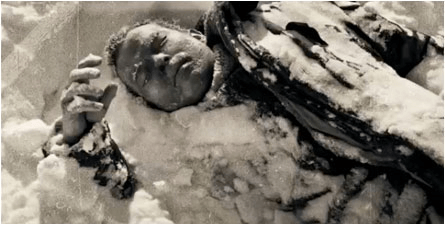
© Another of the victims | The Dyatlov Mystery Unfolded
As for the group that went off to descend the mountain, with the goal of getting help from the nearby town and returning with that help for their waiting friends, they encounter another Zombie - this one taking them completely by surprise. One of the group is attacked, parts of his face are bitten off by the Zombie before they manage to escape the beast. Running and sweating in blind desperation, the four trip, falling down a ravine, suffering bone-breaking injuries.
This explains the fractured skull and chest injuries of the final four bodies somewhat; there would be exterior trauma from the fall although none was observed on the bodies when they were found - some things will never be solved, even with by superior 'Zombie' explanation. Again, maybe these bodies were also "tidied up" by the human counterparts trying to cover up evidence of escaped Zombies. It would explain why the official report says the one who was missing body parts (the one attacked by the Zombie in this theory) was said to have been found with his face partially in a stream - the frigid waters and raging current, eroding away his soft tissues - though photos of the scene clearly show him in a different position.
That covers the main run-down of events. However, one sticking point remains; how did one of the hikers have high levels of radiation in his clothes? That is easily answerable with the Zombie theory. With the mountainous area in question located on an almost direct path between a Russian space launch facility, known for testing the nuclear-warhead fitted R-7 missile, and an area used by the Soviet Union for nuclear testing, it is highly likely that one of the wandering dead received at least some radioactivity when the missiles flew overhead, especially considering that the walking corpse could have been up there for quite some time. Using the opposite hypothesis of Zombies breaking forth of a secret military lab, that lab, if on the mountain itself, would require power - power which could easily be provided by a nuclear generator. The living dead would almost certainly have absorbed some radiation from this power supply, either during its escape or slowly, over its years of captivity due to inadequate shielding.
Conclusion
After documenting the Dyatlov Pass Incident, describing the very bizarre findings of the rescue operation and listing several of the main theories (there are more, including an attack by Yeti or the native Mansi tribespeople), I've dropped my own pulsating theory into the mix: The Zombie Theory. I think the case is fairly strong for Zombies, even if there is a lot of coincidence and guesswork involved. However, the mystery of Dyatlov Pass has captured the minds of researchers and the media for decades, the answer evading all of them for over fifty years. Perhaps the truth will come out in the near future or perhaps we will never know what exactly happened to those nine hikers. The only concrete truth is this: Zombies never die unless purposefully terminated - if they were their once, they are likely still there now.
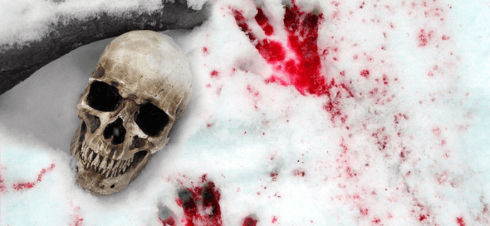
© The Mystery Continues | Mountain of the Dead
DESCRIPTION:
In this article - the first of a brand new series - I take a look at the mysterious Dyatlov Pass Incident. To this day, this fateful event remains unexplained. There are many, many theories for what led to the deaths of nine hikers out climbing on the Pass but now there is another; The Zombie Theory...
CATEGORY:
Zombie Crier
WRITTEN BY:
DATE UPLOADED:
28/06/2015